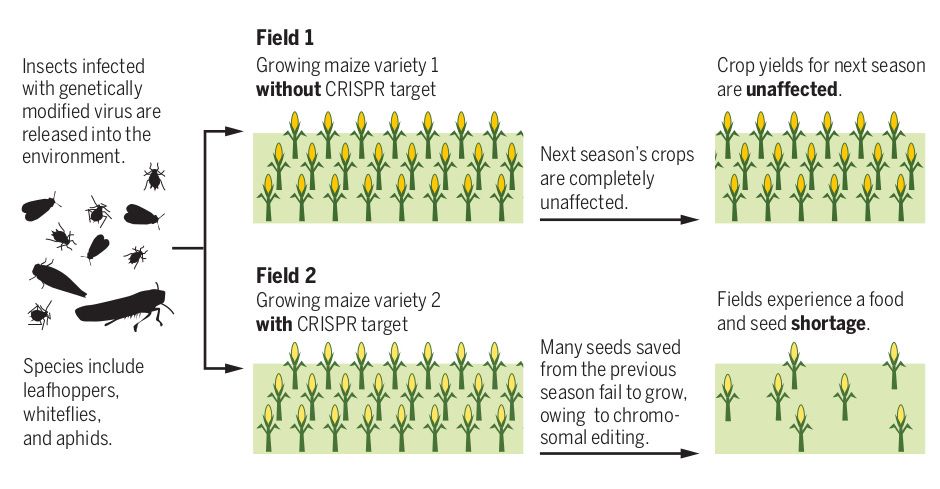Thanks to the latest article from Igor Chudov
("COVID Vaccine Technology" will Depopulate Varroa Mites by Making them Infertile)
I am now aware of this company and their research, that seems to be promoted by the EU (Ref. 1).
This is the most crazy madness ever! They are talking about using a Bioweapon based on dsRNA (Double Stranded RNA) as a pesticide that triggers RNAi (RNA Interference) and gene silencing causing death or any other conceivable disease to the target!!
I've searched for their company and their research, which you can find here, GreenLight Biosciences (Ref. 2).
{NOTE 1: Regarding this picture from them… I already have all my RNA accessible to me. What are they trying to make you believe here?}
I will focus on their previous work, which is on pesticides. You can read some of their work here:
Editorial: New Applications of Insecticidal RNAi, (Ref. 3),
First Sprayable Double-Stranded RNA-Based Biopesticide Product Targets Proteasome Subunit Beta Type-5 in Colorado Potato Beetle (Leptinotarsa decemlineata), (Ref. 4).
In (Ref. 3), where they talk about
[technology that will support long term sustainability goals for the environment],
[Sounds familiar? Do you know all 17 SDGs? (Sustainable Development Goals, (Ref. 5)]
they have developed a Targetable Sprayable Bioweapon:
[Sequence complementarity of the RNAi pathway permits targeted silencing of essential genes and reduces the likelihood of impacts on non-target organisms.]
[The first sprayable RNAi-based biopesticide product (active ingredient ledprona) targets an essential gene in Leptinotasa decemlineata, Colorado potato beetle (CPB). Rodrigues et al. showed ledprona has a new mode of action, where long dsRNA is processed into 21 nucleotides small interfering RNAs (siRNAs) that complement, bind, and cleave CPB proteasome 20S subunit beta-5 (PSBM5) mRNA and compromise its protein production. Ledprona represents a new biopesticide class for integrated pest management (IPM) and insecticide resistance management programs against CPB (Rodrigues et al.).]
From (Ref. 4):
[PSMB5 is part of the ubiquitin/proteasome machinery that removes damaged proteins and prevents the accumulation of poly-ubiquitinated protein aggregation in the cells (Hershko et al., 2000).] Thus, it renders the cell incapable of repairing itself!
{NOTE 2: The illustration above is also from them, however the link seems to be broken (Ref. 6)}
PS: If you change the code of the dsRNA and you target a Human Gene, you could spray this poison (via the required mechanism of action for Humans) and kill every single Human Being that interacts with it in the most horrible way imaginable. You could also promote Chornic disease or sterility, depending on the genes that you target. This is insane!
Take a look (Ref. 7): “Surprisingly, transfection of these dsRNAs into human cell lines caused long-lasting and sequence-specific induction of targeted genes.”
It reminds me a lot to this alarming paper (Ref. 8):
Agricultural research, or a new bioweapon system?
REFERENCES:
(Ref. 1) EU iplantawebinars. https://www.iplantawebinars.com/webinar-one/iPlanta%20webinar%2020201201_recordingGL.pdf
(Ref. 2) 2022 GreenLight work published in peer-reviewed academic journals. https://www.greenlightbiosciences.com/2022-greenlight-research-published-in-a-peer-reviewed-academic-paper/
(Ref. 3) Editorial: New Applications of Insecticidal RNAi. https://www.frontiersin.org/articles/10.3389/fagro.2022.903841/full
(Ref. 4) First Sprayable Double-Stranded RNA-Based Biopesticide Product Targets Proteasome Subunit Beta Type-5 in Colorado Potato Beetle (Leptinotarsa decemlineata). https://www.frontiersin.org/articles/10.3389/fpls.2021.728652/full
(Ref. 5) Do you know all 17 SDGs? https://sdgs.un.org/goals
(Ref. 6) Error 404. https://www.greenlightbiosciences.com/blog/the-economist-cell-free-biotech-will-make-for-better-products/
(Ref. 7) Small dsRNAs induce transcriptional activation in human cells https://www.ncbi.nlm.nih.gov/pmc/articles/PMC1859931/
(Ref. 8) Agricultural research, or a new bioweapon system? https://www.voltairenet.org/IMG/pdf/10-1126_science-aat7664.pdf







Have they ever checked where else as in what species does similar gene expression happen. Sounds crazy. This is a very interesting find with disturbing applications. While all pesticides are bio weapons this seems particularly badly targeted
This is a dandy idea about bee-parasites because different species probably don't share signaling pathways.~
2005: [TOR] Target of Rapamycin-dependent Activation of S6 Kinase Is a Central Step in the Transduction of Nutritional Signals during Egg Development in a Mosquito (UC Riverside, Hansen I et al. doi.org/10.1074/jbc.M500712200)
"Amino acid signaling via the target of rapamycin (TOR) pathway has been identified as a key requirement for the activation of egg development after a blood meal. We report the characterization of the TOR kinase and one of its major downstream targets, S6 kinase, of the yellow fever mosquito Aedes aegypti during egg development in adult females. Both TOR and S6K mRNA are expressed at high levels in the ovaries and in lower levels in fat body and other tissues.... RNA interference-mediated reduction of S6 kinase strongly inhibits the amino acid-induced up-regulation of the major yolk protein vitellogenin in vitro and effectively disrupts egg development after a blood meal in vivo. Our data show that TOR-dependent activation of S6 kinase is a central step in the transduction of nutritional information during egg development in mosquitoes."
2016: "Proteins Deregulate Akt-mTOR Signaling in Human Fetal Neural Stem Cells to Inhibit Neurogenesis and Induce Autophagy." "The current widespread outbreak of Zika virus (ZIKV) infection has been linked to severe clinical birth defects, particularly microcephaly, warranting urgent study of the molecular mechanisms underlying ZIKV pathogenesis. Akt-mTOR signaling is one of the key cellular pathways essential for brain development and autophagy regulation. Here, we show that ZIKV infection of human fetal neural stem cells (fNSCs) causes inhibition of the Akt-mTOR pathway, leading to defective neurogenesis and aberrant activation of autophagy. By screening the three structural proteins and seven nonstructural proteins present in ZIKV, we found that two, NS4A and NS4B, cooperatively suppress the Akt-mTOR pathway and lead to cellular dysregulation." (Liang Q et al. doi: 10.1016/j.stem.2016.07.019.)
2021: "Zika Virus Congenital Syndrome and MTOR gene variants: insights from a family of dizygotic twins.": "We performed a complete exome sequencing in a set of dizygotic individuals and their parents. After that, we selected discordant variants on the MTOR gene between the affected and unaffected twin and we observed a mutation (rs2295079), placed in a region restricted to proximal 5'-UTR, as a strong possible causal variant. In addition, in most brain tissues (including fetal brain) evaluated for expression quantitative trait loci (eQTL), this locus is strongly correlated with post-translational modifications of histones (promoter and enhancer marks) and hypersensitivity to DNAse I (open chromatin mark). Taken together, our data suggest that changes in the MTOR gene may be related to CZS. Additional functional studies should be carried out to prove how and why a MTOR mutation can predispose the fetus to the syndrome."
How and why:
TOR is an evolutionarily conserved regulator of cell growth (Kunz J et al. 1993, Brown EJ et al. 1994, Chiu MI et al. 1994, Sabitini DM et al. 1994, Sabers CJ et al. 1995, Oldham S et al. 2000, Zhang H et al. 2000)
2015: "Roles of mTOR Signaling in Brain Development" (Lee DY, doi: 10.5607/en.2015.24.3.177).
2019: "Novel roles of mechanistic target of rapamycin signaling in regulating fetal growth" (Gupta and Jansson doi.org/10.1093/biolre/ioy249).
2019: German DW news: "Genetically modified mosquitoes breed in Brazil: After a field experiment between 2013 and 2015, genetically modified mosquitoes are breeding in Brazil. According to the researchers' original plan, all released mosquitoes and their offspring should have died."
https://www.dw.com/en/genetically-modified-mosquitoes-breed-in-brazil/a-50414340